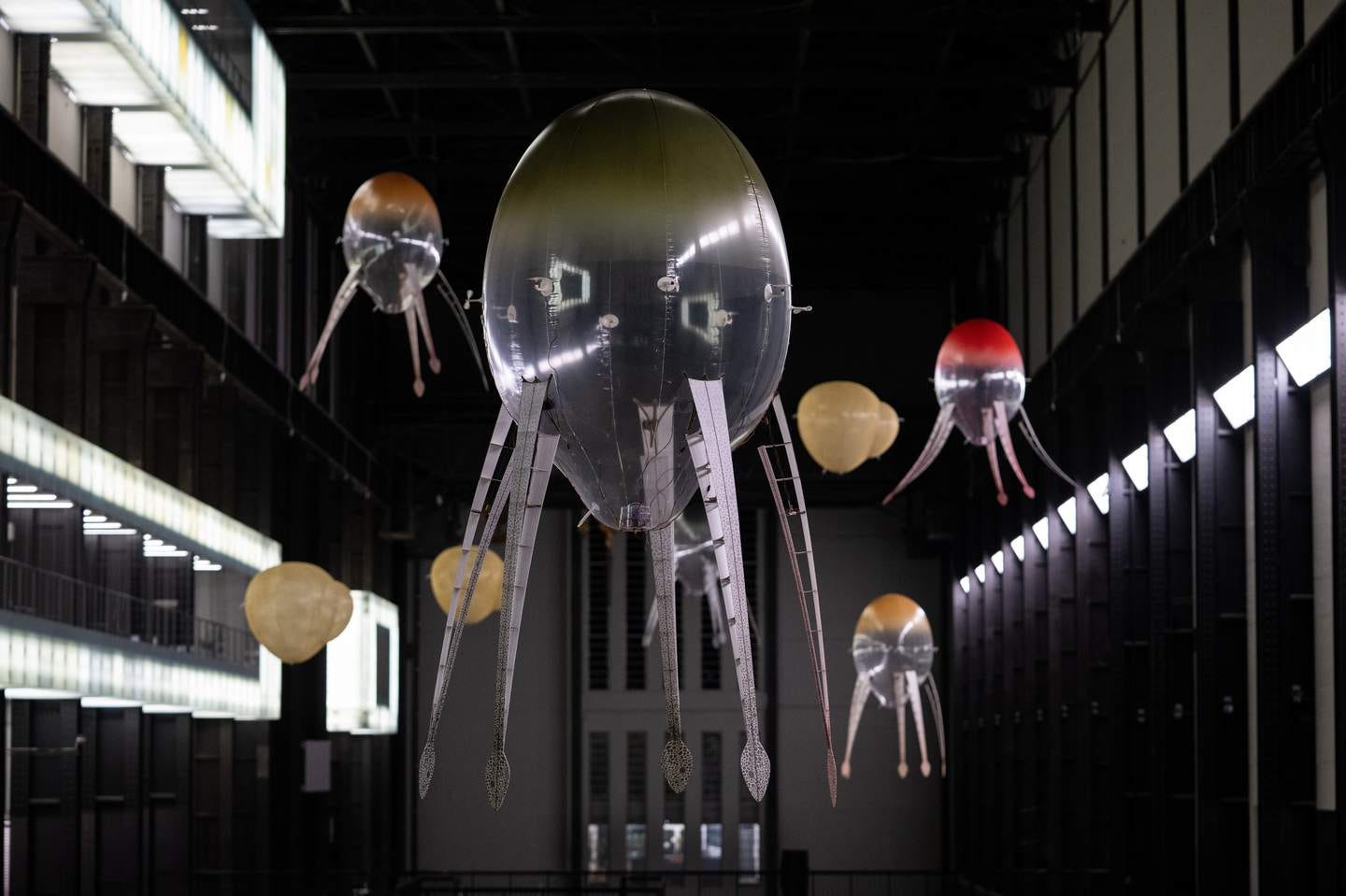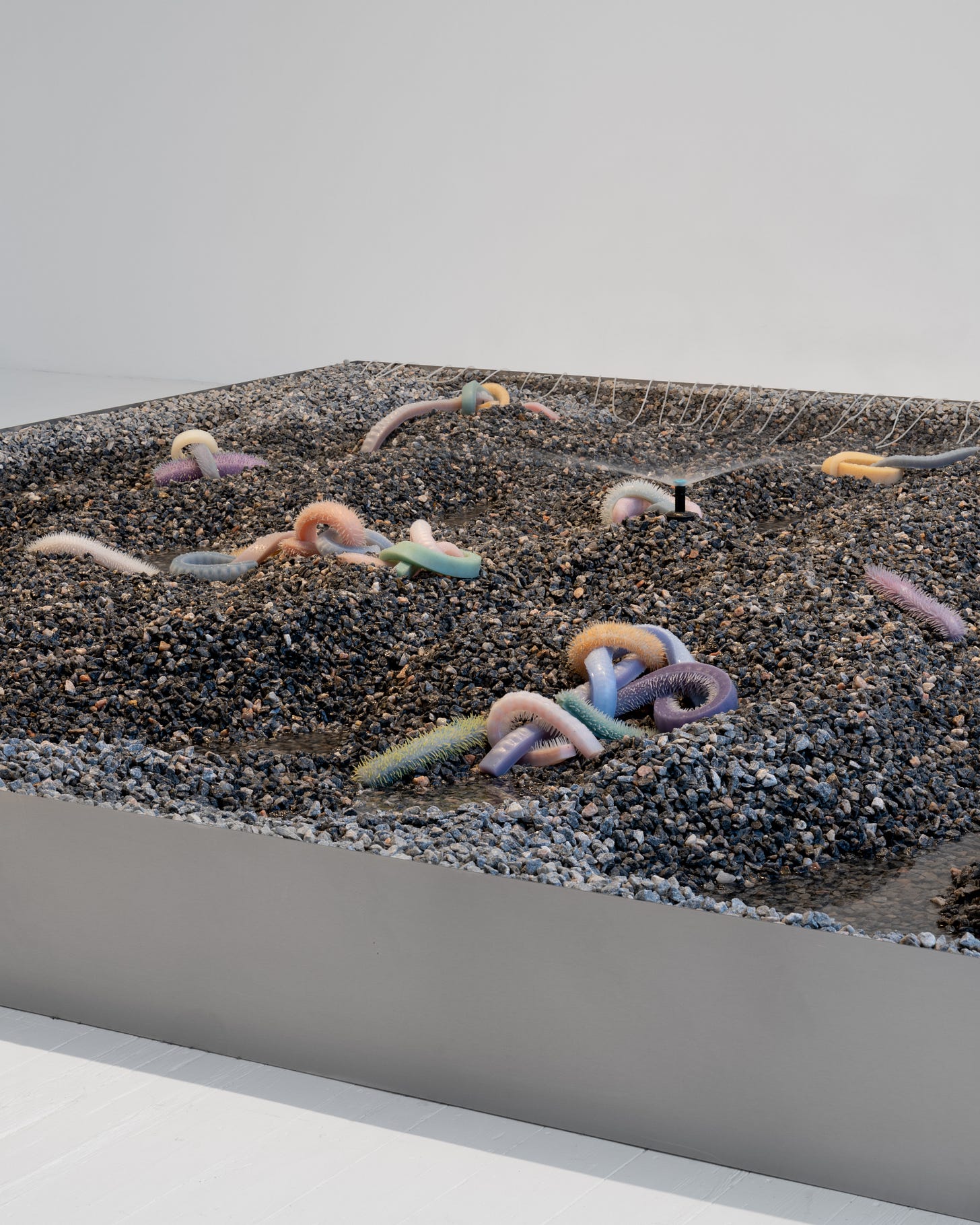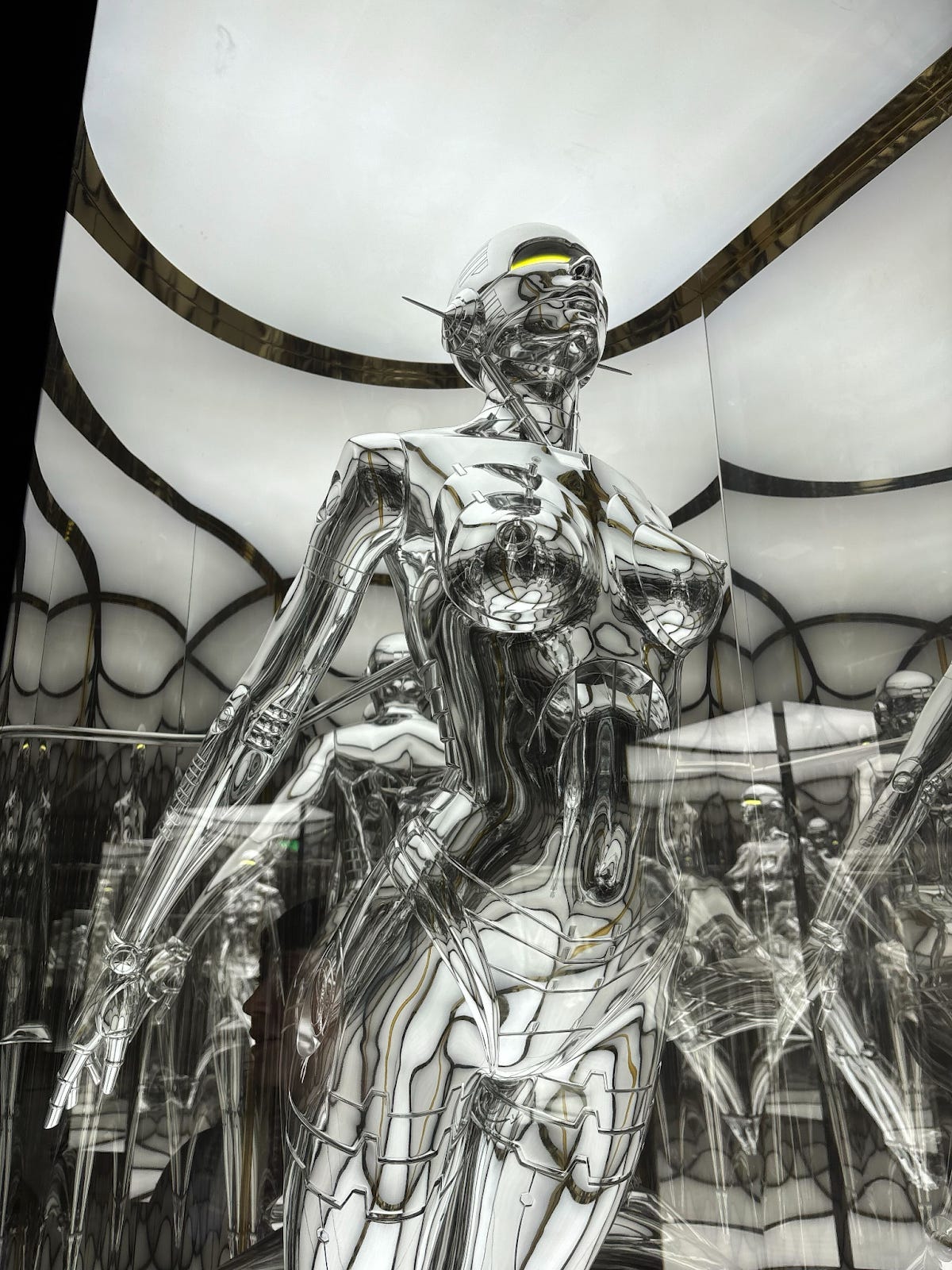In Praise Of Useless Robots
Soft automata, divergent futurisms, and the aesthetic contemplation of machines
A few months ago, I visited the Futurism retrospective organized to mark the 80th anniversary of Filippo Tommaso Marinetti's death at the National Gallery in Rome. The rooms were filled with archives of an ultra-modernist machinic dream: posters, paintings, and sculptures coexisted alongside engines, telegraphs, cars, and airplanes. It was impossible to ignore the voice of the visionary ideologue of Futurism echoing through the sober neoclassical halls of the museum: “We affirm that the magnificence of the world has been enriched by a new beauty: the beauty of speed.” For the Futurists, every machine was, essentially, a time-machine: more than tools designed to perform a specific task, technological objects were the historical embodiment of humanity's universal drive toward progress. Looking beyond the notoriously controversial implications of its political affiliations, the genius of the Futurist avant-garde was its intuition that the evolution of machines could capture cultural transformations better than any other human practice. And thus, even the arts and letters—the highest expressions of humanism—had to listen to the roar of engines.
In October 2021, visitors to London's Tate Modern entered a space populated by visions of a very different future. Floating, semi-transparent organisms hovered slowly in the air like seraphic creatures from the ocean’s depths. These aerobes, as they were baptized by Korean-American artist Anicka Yi, who conceived them, are pachydermic, calm, and silent. These flying automata respond to human presence, changing altitude and behavior based on the proximity of people in the space. “When you look at these aerobes, it gives you a feeling almost opposite to the uncanny valley”, Yi explains. “You know that they're mechanical, yet they feel palpably alive”. Unlike anthropomorphic robots, whose imperfect resemblance to humans often generates a sense of subtle unease (or “uncanniness”), Yi's automata are neither disturbing nor reassuring, but designed to evoke a sense of sublime otherness, like swimming alongside a whale in the sea. Their scale is imposing, but their presence invites attention rather than fear. These artistic-technological objects are difficult to define: they are man-made artifacts but serve no instrumental function. They move around their environment guided by their perceptions, interacting with each other and the world around them. Yi describes them, borrowing a term from Donna Haraway, as “a new kind of companion species”. In Haraway's terms, a “companion species” is not a familiar reflection of the human but a meaningful otherness, whose distance from us enables us to inhabit new forms of relation and coexistence.

Robots are strange objects of inquiry. Whenever I encounter them in my research, I catch myself pondering the contrast between their negligible impact on my daily life and their imposing presence in my cultural imagination. Of course, industrial robots already serve significant purposes, but their usefulness does not entirely justify the appeal they hold towards us. Beyond their intended use, each robot, in its synthetic and self-contained individuality, seems to embody something like the quintessence of the technological object. There is something paradigmatic and powerful about these beings that dominates our imagination of the future. And while for a long time the word “robot” has corresponded to a very specific image (an anthropomorphic, mechanical, rigid artifact), Anicka Yi's flying automata signal a broader change in how these technological objects are imagined and constructed.
Over the past twenty years, robotics has undergone a significant transition. A field once dominated by anthropomorphic bodies and rigid materials has begun to embrace a much wider range of possible incarnations, starting with the use of plastic and flexible materials to replace steel and hard polymers. Cecilia Laschi, one of the most authoritative figures in the field of robotics, has frequently emphasized how this transition from “rigid” to “soft” robots goes far beyond a simple change in the choice of materials, reflecting instead a broader transition in the entire anatomy of the automata, in the strategies used to control them, and in the philosophy that drives their construction. The most notable engineering achievement by Laschi and her colleagues at the Sant'Anna Institute in Pisa is a robotic arm originally designed in 2011 and inspired by the muscular hydrostatics of the octopus. In octopuses, limbs are capable of complex behaviors such as swimming and manipulating objects through coordinated deformations of muscle tissue, without any need for rigid components. In the robot designed by Laschi and her colleagues, the robotic limb’s movement is achieved similarly through deformable smart materials known as “shape memory alloys.”

Unlike a conventional robot, these movements are not pre-programmed, but emerge from the material's response to external forces. This new engineering logic is part of what Laschi describes as embodied intelligence, an approach in which the robot's behavior emerges from integrating its physical structure and interaction with the world. The concept of “embodiment” challenges the hierarchical separation between body and mind, representation and experience. Rather than conceiving of intelligence as the product of an active mind controlling a passive body, embodiment emphasizes the relationship between cognition and corporeality. Originating in philosophy, over the last twenty years, this concept has begun to spread and establish itself in the field of engineering, opening up new avenues for the design of versatile and adaptive robots. “The octopus is a biological demonstration of how effective behavior in the real world is closely linked to body morphology,” Laschi and her co-workers explain, “a good example of embodied intelligence, whose principles derive from the observation in nature that adaptive behavior emerges from the complex and dynamic interaction between body morphology, sensorimotor control, and the environment.”
Back in Shanghai, some time after visiting the National Gallery, I visited a retrospective on Hajime Sorayama, a Japanese artist famous for having crystallized the image of the twentieth-century robot into a simultaneously futuristic and nostalgic icon. Since the 1980s, Sorayama has reproduced the same sculpture endlessly with minimal variations: a slender, curvy female figure covered in chrome-plated armor, halfway between erotic fetish and deity of a long-lost future. These works, laconically branded “Sexy Robot” followed by a serial number, seem to both celebrate and poke fun at the modernist stereotype of the automaton as a triumph of control and mechanical efficiency, replicating the seductive mirage of glittering, endless progress. While Yi's creatures project us into an alien and still nascent technological future, Sorayama’s figures are captivating precisely because they perfectly reflect our expectations. If Yi’s aerobes are soft, sensitive, and radically non-human, Sorayama’s sexy robots are superhuman, dazzling, and wonderfully unfeeling.
Despite their radical aesthetic and philosophical distance, Sorayama’s and Yi’s robots have at least one thing in common—their uselessness. More specifically, they are both instruments of aesthetic contemplation rather than functional tools. Robots, for that matter, are often described in terms of what they can do: as artifacts designed to facilitate work, if not carry it out in our place. This conception, already spelled out in the familiar etymology of the word “robot” (from the Czech robota, “forced labor,” a term popularized by science fiction writer Karel Čapek), is deeply entrenched in twentieth-century industrial culture. Still, even before being called by that name, robots weren’t always just tools in the service of human productivity.
In a 1964 article entitled Automata and the Origins of Mechanism and Mechanistic Philosophy, historian of technology Derek de Solla Price traced the history of automata from antiquity, challenging the notion that such machines were created primarily to serve human labor. Mechanisms, he observed, long functioned as epistemic devices before they became useful tools: they acted as microcosmic mirrors to the greater order of the world. For centuries, automata accompanied the human imagination, helping thinkers to conceive of a rational universe governed by regular mechanisms (well before such mechanisms could be practically put to work). This historical lineage complicates the view of the machine as a purely instrumental tool: its material utility was often secondary to its epistemic power. This non-utilitarian interest in robots has been emerging time and time again in art practices. In After Care, an installation recently exhibited at Copenhagen Contemporary, artists Rhoda Ting and Mikkel Bojesen set fully soft, pneumatically activated robots to wriggle and burrow inside a large pit of rocks and dirt. Visitors were invited to handle the robots as if in a “petting zoo”—engaging with them not as instruments but as alien “companion species,” valued more for their strangeness and presence than for any practical use.

The work of Cecilia Laschi and many other pioneers in robotics is already demonstrating that new soft robots can significantly expand the functionality, sustainability, and resilience of technologies from past centuries. However, beyond the still limited applications of these artifacts, the soft machines of the 21st century seem to signal a more complex transition, primarily epistemic and cultural, in our understanding of and relationship with the world. Yi's fluttering creatures and Ting and Bojesen’s wriggling mollusks exist in continuity with a long history in which technological artifacts were philosophical and cosmological devices before being tools programmed to perform a task. And if the automata of past centuries spoke of celestial spheres and universes orchestrated like clockwork, what worlds do the soft machines of the 21st century evoke? Even contemporary robots, whether swimming in engineering laboratories or floating in art galleries, are first and foremost cosmological mirrors, and the worlds they evoke are very different from those of their ancestors. The new automata, it seems, speak to us of ecological continuity, profound otherness, and possible coexistences with that which is most distant from us.
Bibliography
Cianchetti, M., A. Arienti, M. Follador, B. Mazzolai, P. Dario, and C. Laschi. 2011. “Design Concept and Validation of a Robotic Arm Inspired by the Octopus.” Materials Science and Engineering: C 31(6): 1230–39. https://doi.org/10.1016/j.msec.2010.12.004.
De Solla Price, Derek J. 1964. “Automata and the Origins of Mechanism and Mechanistic Philosophy.” Technology and Culture 5 (1): 9–23. https://doi.org/10.2307/3101119.
Haraway, Donna. 2003. The Companion Species Manifesto: Dogs, People, and Significant Otherness. Chicago: Prickly Paradigm Press.
Laschi, Cecilia, Barbara Mazzolai, and Matteo Cianchetti. 2016. “Soft Robotics: Technologies and Systems Pushing the Boundaries of Robot Abilities.” Science Robotics 1 (1): eaah3690. https://doi.org/10.1126/scirobotics.aah3690.


